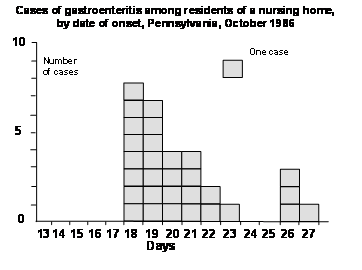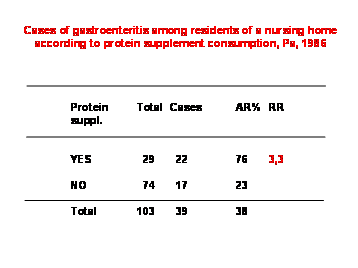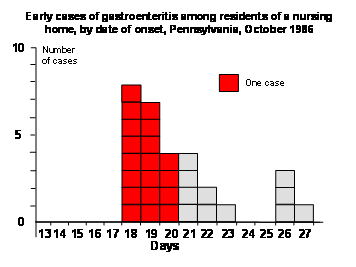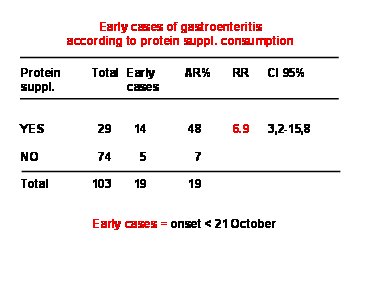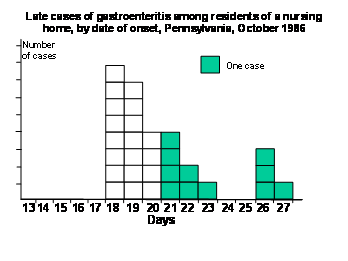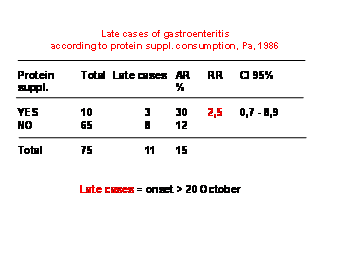Distinguishing Different Sources or Modes of Transmission during an outbreak
We can sometimes observe several modes of transmission or several vehicles during the same epidemic. As a consequence analysis should be detailed, stratified, in order to unmask different associations (or strength of) undetected by a crude analysis.
A common scenario, particularly in schools with young children, or other institutions where normal hygiene standards may not be achievable, is an initial point source infection followed by secondary cases due to person to person spread. In such a situation, the analytical investigation as to the possible source of the outbreak is likely to be more efficient if confined to cases that could reasonably have resulted from the initial point source. Including secondary cases due to person to person transmission will only dilute the analysis.
The following graph shows occurrence of cases of gastroenteritis in a nursing home due to consumption of a protein supplement given to some of the residents (ref.). The epidemic curve suggests a point common source but the second group of cases suggests that secondary transmission may have occurred. (A number of possible modes for this transmission can be hypothesised, eg left over food, person to person transmission, or another food item involved).
Source: Pennsylvania department of health. USA
This possibility was explored through a retrospective cohort study conducted among the 103 residents suggested that the protein supplement given to some residents was the likely vehicle of the epidemic. Results of the study are shown in the following table. The risk of gastroenteritis is 3.3 times higher among those who ate the protein supplement than not.
Source: Pennsylvania department of health. USA
In order to assess if the protein supplement playedthe same role at the beginning and at the end of the epidemic, the curve was divided into an early and late phase. The analysis was redone using early cases as cases, all other cases being in the cohort denominator since still at risk on the 21 of October 1986.
Source: Pennsylvania department of health. USA
The results are shown in the following table. It seems that risk of being an early case is higher for protein eater than not. But this time the RR is 6.9 suggesting that the relative risk is higher in the early phase of the outbreak.
Source: Pennsylvania department of health. USASource: Pennsylvania department of health. USA
Source: Pennsylvania department of health. USA
The same was done for late cases. Late cases were used as cases and early cases were excluded from the denominator since no longer at risk.
Source: Pennsylvania department of health. USA
The following results were obtained. The relative risk of gastroenteritis is now 2.5 suggesting a lesser role of the protein supplement in occurrence of illness in the second part of the epidemic.
Source: Pennsylvania department of health. USA
==FEM PAGE CONTRIBUTORS 2007
- Editor
- Graham Fraser
- Original Authors
- Alain Moren
- Marta Valenciano
- Contributors
- Arnold Bosman
- Graham Fraser
- Lisa Lazareck
- Aileen Kitching
- Vladimir Prikazsky
